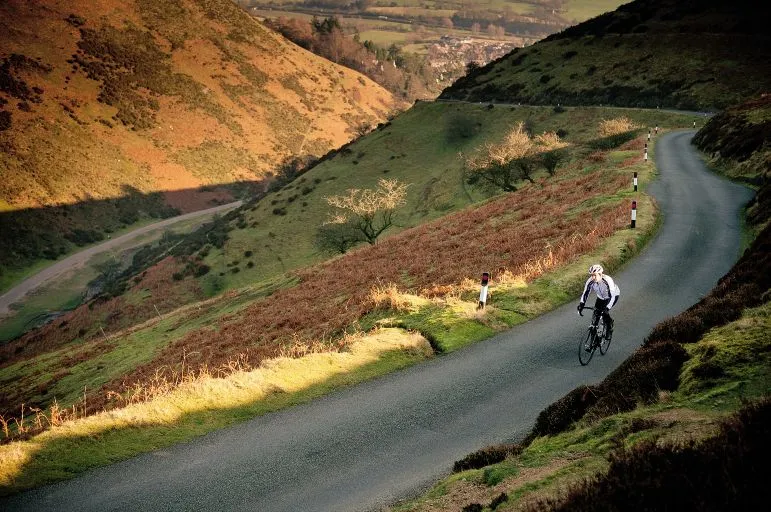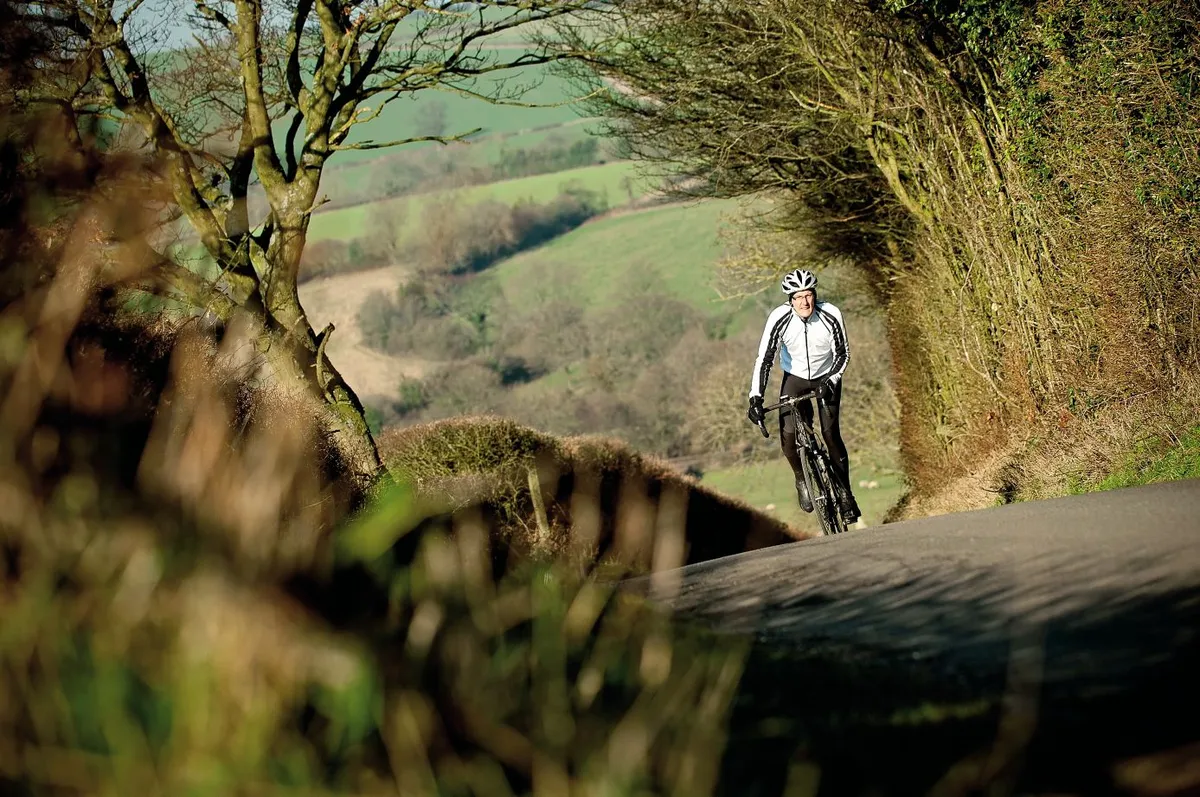Ride Information
- Distance 71 miles
- Climbing 1624m
- Grade Hard
- Maps OS Landranger 138 Kidderminster & Wyre Forest, 137 Church Stretton and Ludlow, 127 Stafford and Telford
- Download the route
There’s a small corner of Shropshire where people get a bit upset if you suggest the modern Olympics were founded by a Frenchman – and they have a point. Baron de Coubertin might be thought of as having started the modern Olympic movement with the Athens Games in 1896, but you could argue that a Shropshire GP called Dr William Penny Brookes set the template with the first ‘Wenlock Olympian Class’ back in 1850.
The games became an annual fixture, and continue to this day. Cycle racing arrived as early as 1876, a full two decades before the first starter’s pistol was fired at de Coubertin’s Olympics.
When the Olympics came to London in 2012, Dr Brookes at last started to get the recognition he deserves for founding his own Olympic tradition, and for inspiring his better known French counterpart. Maybe we need to rethink the identity of Britain’s first Olympic cycling hero, too. The winner of the first cycling race in the Much Wenlock Games was Tom Sabin from Allesley in Coventry. Sabin was one of four riders competing over eight laps of Linden Field, a total of three miles.
I’m in Much Wenlock to pay my respects to Dr Brookes and to Sabin, but rather than ride around Linden Field, I’m going to explore some of the best cycling roads this part of Shropshire has to offer.
I start out from the Much Wenlock Museum. From here the route heads out of town, past black and white timber buildings just a few yards from Linden Field, where Tom Sabin took on J Fieldhouse, JE Cox, and JO Richards some 136 years ago.
After a brief spin on the main road heading north, the route turns left for a few twisty miles of short, sharp climbs and short, sweet descents. There’s enough mud and gravel on the road to make sure these early miles wake up the mind as well as the legs.

welsh giants
With a couple of stiff climbs under my tyres, the road straightens and the gradients ease. Time to take in the scenery of gently folded farmland and settle into a rhythm. There’s still frost on the ground in shady patches untouched by the morning sun and, to the left, the wooded escarpment of Wenlock Edge is silhouetted against a pale blue sky.
I may be taking the scenic route, but this is no gentle tour and the going soon gets lumpy again. The route is heading towards Wales and although the place names are all English, the most imposing hill in sight, Caer Caradoc, has a very Celtic look and name. It rises up out of the farmland like a boulder thrown centuries ago by an angry Welsh giant.
The route turns away before we reach the foot of Caer Caradoc, but that simply swaps one hill for another. I pass a sign for the village of Wall, and right on cue the road ramps up and has me shifting the chain as far left as it will go. Tom Sabin and his rivals had no big hills to cope with, but then again their bikes weren’t made out of carbon fibre with 30 gears. The pace of the race must have been tough, though. One of the four riders, Richards, abandoned at the halfway point having been lapped. Cox threw in the towel a lap later, leaving a straight fight between Sabin and Fieldhouse.
I’m now just a few miles from my biggest fight of the day – The Burway. I’ve ridden this climb before so I know it’s a knee-buckler. After a steady ascent past rust-coloured hills and a welcome downhill blast down into Church Stretton, it’s time to face the foe…

wall of pain
The 20 per cent gradient sign reinforces what my eyes have recorded – this hill is going to hurt. Not for the first time, I’m in my lowest gear and still flicking the lever in the hope that a 32-tooth sprocket will appear out of nowhere. It doesn’t, so I dig in for the long haul. Over the cattle-grid and around the bend, I feel like a cartoon cyclist who’s just ridden into a wall. I’m relieved there are no ramblers about as I suspect they’d overtake me with a cheery wave. The views are worth the effort, though. The Burway climbs up one side of Carding Mill Valley, a jagged slice carved from the side of the Long Mynd (the name means long mountain). Its mottled greens, browns and greys look especially beautiful in the soft spring light.
After the first mile or so the hardest work is done, but the respite is limited as one false summit replaces another. It’s noticeably colder up here at 500 metres, and at the very top snow has turned the heathland white. In truth it’s bitter, but being in a glass-half-full mood I tell myself the weather is bracing and pedal faster to keep out the cold.
After a few miles of riding in undisturbed solitude, the road off the Long Mynd feels like jumping off a cliff. At 25 per cent, Asterton Bank is even steeper than The Burway, but dead straight, narrow and mossy over the crown of the road. It’s a blast to ride in summer, but given the cold weather I’d have my fingers crossed if they weren’t oh-so-gently squeezing on the brakes.
I reach the bottom without drama, and head west. Although the Long Mynd feels like a natural border, Wales is actually a few miles further on, but I cut back to the south east just before the true border.
A rare stretch of flat, well surfaced main road lets me crank up the pace. The higher speed doesn’t last for long, though. The arc I’ve taken around the southern end of the Long Mynd has brought me back to the Shropshire Hills, and more hard climbing. The contour lines huddle together like cold sheep in these parts.
Some fast descents are the reward for chewing down on another two tough hills. The run into Craven Arms is the best yet, with some open, flowing sections to really build some big-ring speed.
From Craven Arms the road climbs again, but far more gently than before. After munching on an energy bar and swigging down some icy water, the next few miles pass easily.
There’s more hard work to come, though, as just to the east there’s another range of hills to play in: the Clees. Some winding miles on minor roads bring me to the foot of Brown Clee, the highest hill in Shropshire with the summit at 540m (fortunately for my legs and lungs, the road doesn’t go near the top).
Like The Burway, the steepest section hits early, but the rest of the climb grinds on mercilessly. I only realise how high the road has climbed when I look back clean over Wenlock Edge to the rugged hills beyond. This, I promise myself, is the last really demanding hill of the day, so I savour the ride down the other side and carry as much speed as I can onto the flatter roads heading north towards Ironbridge, so named because the world’s first cast iron bridge was built here in 1779 over the River Severn.

Industrious efforts
By 1876, when Sabin raced Fieldhouse down the road in Much Wenlock, Ironbridge had been a powerful industrial centre for more than a century. Tourism is its big business now, although on a quiet early spring afternoon there’s little sign of that. It’s quiet. Too quiet, as it turns out. Thanks to a road closure I have to haul up an extra hill rather than spinning easily along the river. Convincing myself I know better than the detour signs probably isn’t the smartest move, either…
Thanks to the road closure I’ll need to hurry to make it back before dark. Sabin might not have had to worry about fading light, but he did have Fieldhouse to contend with. For much of the race it was Fieldhouse, not Sabin, who looked the likely winner. However, as the Boro’ of Wenlock Express reported, Sabin took the lead on the penultimate circuit. ‘In the seventh lap Sabin passed his opponent in the straight, and keeping up his spurt, got the best of the hill, and coming away from the Station corner led by about 50 yards.’
Leaving Ironbridge feels like starting the final lap. I cross the Severn and head south towards Much Wenlock. The road rises steadily, but it’s a manageable gradient compared with what has gone before, and I know it ends with one last freewheel downhill back into the town.
going for glory
As for Tom Sabin, his final lap was rather more dramatic, as the Express described: ‘Sabin entered the last lap in splendid style, being 20 yards ahead of Fieldhouse, and maintained the lead, Fieldhouse gradually drawing up to the Quarry corner, from which a rattling and most exciting race issued; but Fieldhouse could get no nearer than three yards, and Sabin won amid loud cheers from the excited crowd.’
I reach my own finish line in more muted style. It’s been a beautiful and varied ride, and a surprisingly tough one. By all means dream of Olympic glory when you're climbing Box Hill, but don’t forget where the first Olympic cycle race was run.
Local Knowledge
Closest station
Church Stretton
www.nationalrail.co.uk
Food and drink
Although there are plenty of villages along the route, not all have cafes or village shops. There’s more choice if you plan to grab a bite in Much Wenlock, Church Stretton, Craven Arms or Ironbridge.
Where to stay
You should have no trouble finding B&Bs, hotels and campsites on or near the route. Try www.shropshiretourism.co.uk and www.virtual-shropshire.co.uk for more details.
Local bike shops
This route takes you a long way from big towns, so it makes sense to carry plenty of spares. If you need to stock up, try Plush Hill Cycles in Church Stretton or Lawley.
Thanks to The Wenlock Olympian Society for its help in researching the first Olympic bike race.
Subscribe to Cycling Plus
Cycling Plus has been seeking out Britain's Best Rides since 1992 – subscribe here!
Sign up to the Cycling Plus Newsletter here
